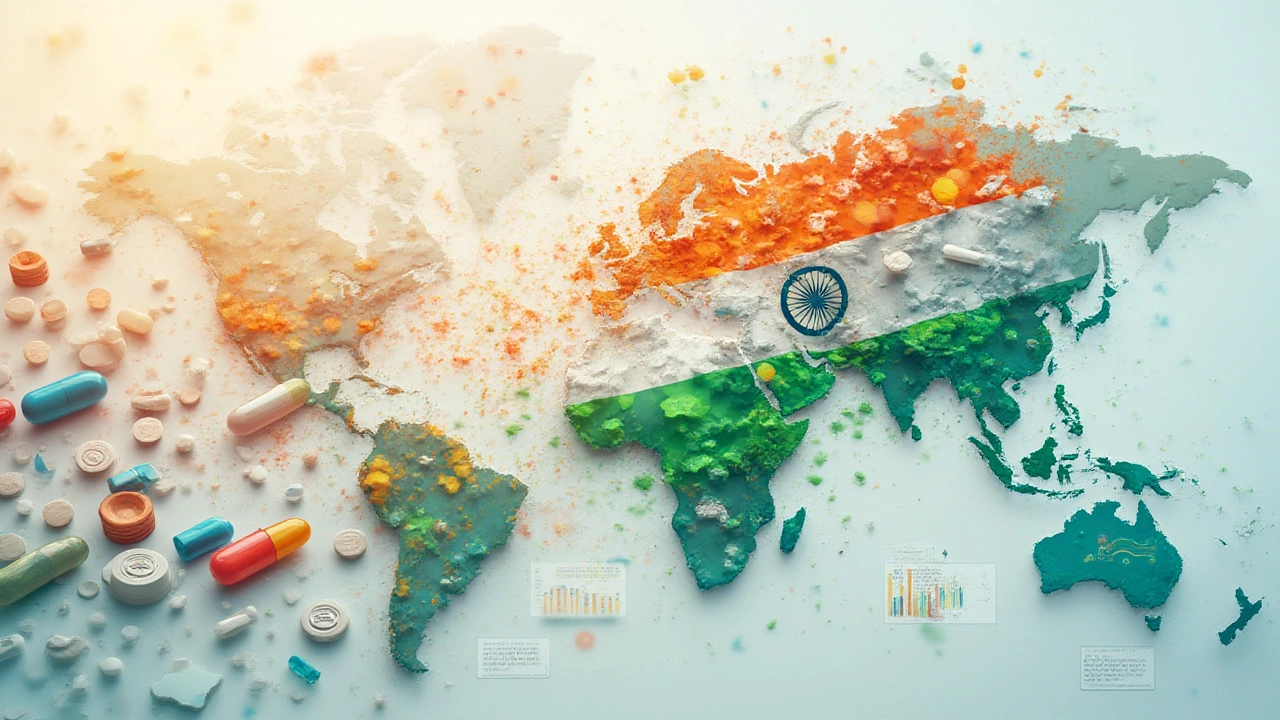There’s a reason folks call India the “pharmacy of the world.” If you’ve ever popped a generic pill in London or LA, chances are it came from India. But behind this global dominance, who’s the real king of Indian pharma? Find any medical conference, and debates will swirl—one name, though, keeps echoing above the noise. Stories about billionaire ambition, boardroom moves, and shipping crates filled with life-saving drugs all point to one man: Dilip Shanghvi. He’s the founder of Sun Pharmaceutical Industries, the giant with roots in a small Calcutta shop, now sprawling across six continents.
The Rise and Reign of Dilip Shanghvi: India’s Pharma King
Dilip Shanghvi’s story isn’t your stereotypical rags-to-riches drama, but it’s close. He started out in the 1980s helping in his father’s wholesale medicine business in Kolkata. Instead of just moving boxes, he figured, “Why not make the medicines ourselves?” He scraped together about 10,000 rupees—not even enough for a flashy scooter these days—and launched Sun Pharma in 1983. The timing couldn’t have been better. India needed cheap drugs, patents were a murky mess, and nobody could compete with Indian hustle and jugaad.
Back then, Sun made psychiatric drugs for a tiny slice of the market. Shanghvi, though, kept reinvesting every rupee. He focused laser-sharp on making generics that people actually needed—antidepressants, epilepsy meds, antihistamines—all the stuff that flies off pharmacy shelves. Pretty soon, Sun had its own fanbase among Indian doctors. But Shanghvi didn’t stop. By the 2000s, everyone in pharma was eyeing the US market. He bought out struggling American generic companies nobody wanted. Each acquisition grew his global reach.
Sun Pharma’s biggest moment came in 2014, with the $4 billion takeover of Ranbaxy Laboratories. It was risky—Ranbaxy had regulatory troubles in the US—but this was classic Shanghvi: turning someone else’s chaos into his advantage. The deal made Sun Pharma India’s biggest, and the world’s fifth-largest, generic drugmaker. By 2024, Sun was selling pills in over 100 countries, with manufacturing plants sprinkled across the globe.
If you want hard numbers, it’s pretty wild. According to the latest reports, Sun Pharma earned revenue of about $6.3 billion (approx. Rs 54,000 crore) in FY 2024. The company regularly invests more than $250 million a year in R&D, chasing everything from cancer drugs to treatments for rare diseases. Shanghvi’s personal wealth? Forbes pegged it close to $24 billion in 2025.
| Year | Sun Pharma Net Revenue (Rs Crores) | Market Cap (Rs Crores) | Global Ranking |
|---|---|---|---|
| 2015 | 27,288 | 200,000 | 9th Generic Maker |
| 2020 | 32,837 | 163,000 | 8th |
| 2024 | 54,000 | 285,000 | 5th |
Shanghvi doesn’t just run a company; he shapes India’s entire pharma industry. He’s famously low-profile—doesn’t hog the limelight, barely gives interviews. Instead, you’ll find him in Sun Pharma’s labs, personally reviewing R&D proposals or obsessing about quality. He’s steered Sun through FDA crackdowns, pricing wars, and public spats with Wall Street analysts. His obsession? Never let Sun become just another drug factory. Push for better, safer, next-generation meds, and never, ever get complacent.
If you’re wondering what gives Shanghvi the edge, it’s this: he combines deep technical knowhow with an eye for business drama. One analyst described him as India’s most methodical risk-taker. And the numbers back it up—Sun Pharma’s consistent US market growth, patent challenge victories, and steady FDA approvals put the company in a league of its own.

Other Titans Trying for the Crown: How They Stack Up
It’s tempting to think Shanghvi wins by a mile, but India’s pharma sector is an all-out battlefield. Let’s size up his closest rivals, because no “pharma king” stays lonely for long.
First, there’s Dr. Yusuf Hamied, chairman of Cipla. Hamied is a legend for other reasons—his company revolutionized AIDS treatment in Africa by selling antiretrovirals at dirt-cheap prices. This “Robin Hood of pharma” played a huge humanitarian role, but Cipla’s global scale isn’t quite at Sun’s level. Even so, Cipla’s annual revenue now tops Rs 23,000 crore, and its focus is shifting toward biosimilars and specialty drugs in Europe and America.
Next up, Pankaj Patel helms Zydus Lifesciences (formerly Cadila Healthcare). Patel made the company a wild card, with Covid-19 vaccines, biosimilars, and some bold US expansion. Zydus clocks over Rs 20,000 crore revenue, with big R&D spends—yet, again, Sun’s global footprint is just bigger.
Not to be left out, Kiran Mazumdar-Shaw, founder of Biocon, is the “biotech queen” but also a major force. She’s been a trailblazer—her company leads India’s push into insulin, biosimilars, and cancer therapies, and lands key deals with US and Europe. Biocon’s revenue in 2024? About Rs 10,500 crore. Impressive, but not enough for the top throne.
There are also big players like Lupin (Vinita Gupta, Nilesh Gupta), Dr Reddy’s Labs (GV Prasad), and Aurobindo Pharma, all snapping at Sun’s heels. Dr Reddy’s, for instance, pulled in around Rs 25,000 crore in 2024 and is known for aggressive growth across Russia, CIS, and North America. Lupin remains a leader in anti-TB drugs and women’s health—its global network is enviable but it’s facing tough margins.
Why is Sun ahead? For one, Dilip Shanghvi’s gamble on the US market paid off big time. Sun’s unique approach to complex generics—injectables, controlled substances, even oncology drugs—helped it dodge brutal price wars others got stuck in. The company also moves faster on patent challenges, so its generics hit shelves before anyone else.
That’s not to say Sun’s way is easy. The company has faced FDA bans, lawsuits, and lots of public criticism—some justified, some just the cost of winning big. Still, when you stack everything up—market share, innovation pipeline, international reach—Sun’s lead is obvious. Rivals may try to catch up, but the gap remains wide as of 2025.
One tip for anyone eyeing a future in Indian pharma: keep an eye on emerging sectors like biosimilars (near-copies of expensive biologic drugs) and super-specialty generics. That’s where the next “pharma king” could be crowned. As regulations and patents get trickier, only those companies willing to bet hard on research and quality will stay at the top.

Why India’s Pharma Crown Matters: Lessons for Entrepreneurs and the World
It’s not just about money and titles. The fact that India kept churning out medicines during Covid, supplying vaccines to Asia, Africa, and even Europe, changed how the world sees Indian pharma. Today, India exports about 20% of the world’s generic medicines by volume. That’s about $27 billion in annual exports, folks. Pharma king of India isn’t just a freakish billionaire—he’s someone whose decisions impact millions of lives worldwide.
But the climb hasn’t been all smooth sailing. The Indian pharmaceutical industry dodged global patents for decades, but now faces rising regulation, tougher inspections, and relentless competition from China. Sun Pharma, Dr Reddy’s, or Cipla—everyone’s had a product banned or a plant shut for quality lapses. That’s a wake-up call for new entrants: whatever shortcuts worked in the 80s don’t cut it in 2025. You need robust R&D, ironclad quality systems, and a moral compass—it’s about saving lives, not just raking in profit.
Real talk for someone looking to build a pharma business: obsess over compliance and traceability from day one. The US FDA or the European Medicines Agency can blacklist you faster than you can spell “acetaminophen.” Build strong teams of scientists, not just sales reps. Follow Shanghvi’s lead: it pays to keep a low profile but an eagle eye on every detail that matters, especially in supply chain security and IP management.
There’s an emerging trend that’s hard to ignore—digital health, AI-driven drug discovery, and sustainable “green chemistry.” The Indian government has started backing startups in these zones with special subsidies and incentives. If you’re dreaming of challenging the king, you need to mix old-school hustle with 21st-century technology. Invest in automation, data analytics, and partnerships with hospitals and universities. The next disruption won’t come from another copycat, but from someone who reinvents the drug pipeline from the ground up.
If you’re trying to navigate India’s pharma maze for your own business or career, don’t just chase after the old formula. Pick an underserved therapy area, study the toughest unmet patient needs, and go deep there. It’s not just about who makes the most pills, but who delivers the highest real-world impact with the fewest side effects and the most reliability. The path to being pharma royalty is harder than ever, but for those who are bold and smart, the crown is still up for grabs.
